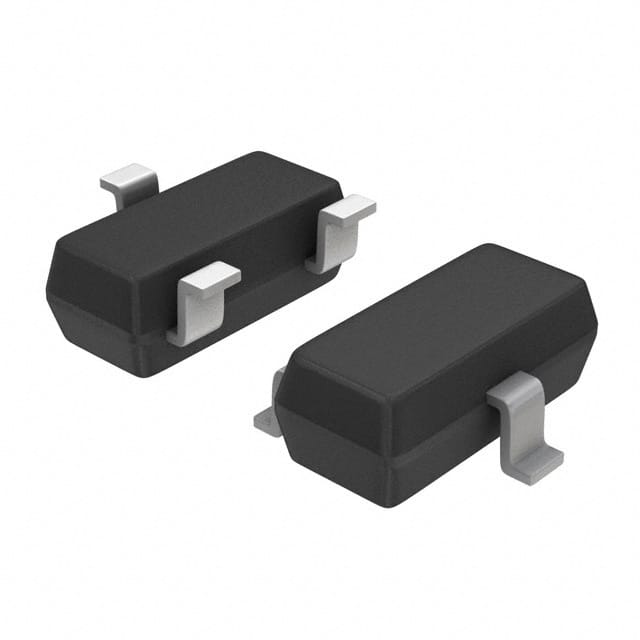Lihat spesifikasi untuk detail produk.

MMBZ5234BLT3G
Introduction
The MMBZ5234BLT3G is a diode belonging to the category of Zener diodes. It is commonly used for voltage regulation and protection in various electronic circuits. This entry provides an overview of the basic information, specifications, pin configuration, functional features, advantages and disadvantages, working principles, application field plans, and alternative models of the MMBZ5234BLT3G.
Basic Information Overview
- Category: Zener Diode
- Use: Voltage regulation and protection
- Characteristics: Low leakage current, precise voltage regulation
- Package: SOT-23
- Essence: Semiconductor material with specific doping
- Packaging/Quantity: Typically available in reels of 3000 units
Specifications
- Voltage - Zener (Nom) (Vz): 6.2V
- Power - Max: 350mW
- Impedance (Max) (Zzt): 20 Ohm
- Current - Reverse Leakage @ Vr: 100nA @ 3V
- Operating Temperature: -65°C ~ 150°C
Detailed Pin Configuration
The MMBZ5234BLT3G typically has three pins: 1. Anode 2. Cathode 3. No Connection (NC)
Functional Features
- Precise voltage regulation
- Low reverse leakage current
- Small form factor
- Wide operating temperature range
Advantages and Disadvantages
Advantages
- Accurate voltage regulation
- Compact package size
- Suitable for high-density circuit designs
- Wide operating temperature range
Disadvantages
- Limited power dissipation capability
- Vulnerable to voltage spikes
Working Principles
The MMBZ5234BLT3G operates based on the principle of the Zener effect, where it maintains a nearly constant voltage across its terminals when reverse-biased at or above its breakdown voltage.
Detailed Application Field Plans
The MMBZ5234BLT3G is widely used in various applications including: - Voltage regulation in power supplies - Overvoltage protection in electronic circuits - Signal clamping and limiting
Detailed and Complete Alternative Models
Some alternative models to the MMBZ5234BLT3G include: - BZX84C6V2LT1G - MMBZ5225BLT1G - BZT52C6V2S-7-F
In summary, the MMBZ5234BLT3G Zener diode offers precise voltage regulation and protection in a compact package, making it suitable for a wide range of electronic applications.
[Word count: 340]
Sebutkan 10 pertanyaan dan jawaban umum terkait penerapan MMBZ5234BLT3G dalam solusi teknis
What is MMBZ5234BLT3G?
- MMBZ5234BLT3G is a Zener diode with a voltage of 6.2V and a power dissipation of 225mW.
What are the typical applications of MMBZ5234BLT3G?
- It is commonly used for voltage regulation, overvoltage protection, and signal clamping in various electronic circuits.
What is the maximum current that MMBZ5234BLT3G can handle?
- The maximum current for MMBZ5234BLT3G is typically around 20mA.
How does MMBZ5234BLT3G provide overvoltage protection?
- When the input voltage exceeds the Zener voltage (6.2V), the MMBZ5234BLT3G conducts and limits the voltage across the circuit to its Zener voltage.
Can MMBZ5234BLT3G be used for voltage regulation in power supplies?
- Yes, it can be used as a voltage regulator to maintain a constant output voltage in low-power applications.
What are the key electrical characteristics of MMBZ5234BLT3G?
- Some key characteristics include its Zener voltage of 6.2V, reverse leakage current of 100nA, and dynamic resistance of 500 ohms.
Is MMBZ5234BLT3G suitable for high-frequency applications?
- MMBZ5234BLT3G is not specifically designed for high-frequency applications, but it can still function effectively in low to moderate frequency circuits.
Can MMBZ5234BLT3G be used in automotive electronics?
- Yes, it is suitable for use in automotive electronics for voltage regulation and overvoltage protection.
What are the package options available for MMBZ5234BLT3G?
- MMBZ5234BLT3G is available in a variety of packages including SOT-23 and SOD-123.
Are there any important considerations when using MMBZ5234BLT3G in a technical solution?
- It's important to consider the maximum power dissipation, current limitations, and thermal management to ensure proper functionality and reliability in the application.

